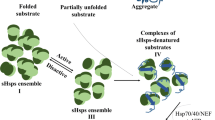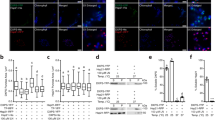Abstract
Heat shock protein 70 is a conserved protein among organisms. Hsp70 helps substrate proteins to fold correctly. Unfolded substrate proteins increase the probability of the aggregate formation. High level recombinant protein expression in biotechnology often leads insoluble inclusion bodies. To prevent aggregation and to obtain high levels of soluble proteins, Hsp co-expression with desired recombinant protein in yeast becomes a popular method. For this purpose, S. cerevesiae cytosolic Hsp70 (Ssa1) biochemical properties were characterized. Alteration of Ssa1 structure between ATP- and ADP-bound states regulates its function. Therefore, conformation-dependent Ssa1 hydrophobicity and as a result aggregation may also play a key role in Ssa1 function. Therefore, a combination of FTIR, acrylamide quenching, and ANS was used to investigate the effect of nucleotide binding on the structure of Ssa1. Ssa1 secondary structure alterations and hydrophobic properties in aqueous solutions with differing ionic strengths and temperature were also studied.








Similar content being viewed by others
Abbreviations
- Hsp:
-
Heat shock protein
- FTIR:
-
Fourier transform infrared spectroscopy
- ANS:
-
8-Anilino-2-naphthyl sulfonic acid
References
Banecki B, Zylicz M, Bertoli E, Tanfani F (1992) J Biol Chem 267:25051–25058
Bhattacharya A, Kurochkin AV, Yip GN, Zhang Y, Bertelsen EB, Zuiderweg ER (2009) J Mol Biol 388:475–490
Borges JC, Ramos CH (2006) Arch Biochem Biophys 452:46–54
Buchberger A, Schröder H, Büttner M, Valencia A, Bukau B (1994) Nat Struct Biol 1:95–101
Buchberger A, Theyssen H, Schröder H, McCarty JS, Virgallita G, Milkereit P, Reinstein J, Bukau B (1995) J Biol Chem 270:16903–16910
Bukau B (1999) Molecular chaperones and folding catalysis. Harwood academic publishers, Amsterdam, pp 139–173
Chernoff YO, Lindquist SL, Ono B, Inge-Vechtomov SG, Liebman SW (1995) Science 268:880–884
Chirico WJ, Markey ML, Fink AL (1998) Biochemistry 39:13862–13870
Fan H, Kashi RS, Middaugh CR (2006) Arch Biochem Biophys 447:34–45
Glover JR, Lindquist S (1998) Cell 94:73–82
Glover JR, Lum R (2009) Protein Pept Lett 16:587–597
Heyduk T, Lee JC (1989) Biochemistry 28:6914–6924
Horowitz PM, Criscimagna NL (1985) Biochemistry 24:2587–2593
Jones GW, Masison DC (2003) Genetics 163:495–506
Kabani M, Beckerich JM, Brodsky JL (2002) Mol Cell Biol 22:4677–4689
King C, Eisenberg E, Greene LE (1995) J Biol Chem 270:22535–22540
King C, Eisenberg E, Greene LE (1999) Biochemistry 38:12452–12459
Lakowicz JR (2006) Principles of fluorescence. Springer, Baltimore, pp 278–327
Lehrer SS (1971) Biochemistry 10:3254–3263
Liberek K, Lewandowska A, Zietkiewics S (2008) EMBO J 27:328–335
Masison DC, Kirkland PA, Sharma D (2009) Prion 3:65–73
Mayer MP, Bukau B (2005) Cell Mol Life Sci 62:670–676
Moro F, Fernández-Sáiz V, Slutsky O, Azem A, Muga A (2005) FEBS J 272:3184–3196
Moro F, Fernández-Sáiz V, Muga A (2006) Protein Sci 15:223–233
Needham PG, Masison DC (2008) Arch Biochem Biophys 478:167–174
Revington M, Zhang Y, Yip GN, Kurochkin AV, Zuiderweg ER (2005) J Mol Biol 349:163–183
Romanova NV, Chernoff YO (2009) Protein Pept Lett 16:598–605
Sharma D, Masison DC (2009) Protein Pept Lett 16:571–581
Shorter J, Lindquist S (2008) EMBO J 27:2712–2724
Slater MR, Craig EA (1989) Nucleic Acids Res 17:805–806
Tutar Y (2003) Structure-function studies with the cAMP receptor protein of E. coli. PhD. Thesis, Texas Tech University, Lubbock, Texas
Tutar Y (2006) Protein Pept Lett 13:301–306
Tutar Y (2006) Protein Pept Lett 13:307–311
Tutar Y (2006) Protein Pept Lett 13:699–705
Tutar Y (2007) Recent Pat DNA Gene Seq 1:125–127
Tutar L, Tutar Y (2010) Curr Pharm Biotechnol 11:216–222
Tutar Y, Song Y, Masison DC (2006) Genetics 172:851–861
Vogel M, Mayer MP, Bukau B (2006) J Biol Chem 281:38705–38711
Weibezahn J, Schlieker C, Tessarz P, Mogk A, Bukau B (2005) Biol Chem 386:739–744
Witt SN (2010) Biopolymers 93:218–228
Woo HJ, Jiang J, Lafer EM, Sousa R (2009) Biochemistry 48:11470–11477
Acknowledgments
This work was funded partly by the Turkish Planning Organization (Grant DPT-K.120220-2006) and through seed grants from the Turkish National Academy of Sciences (TUBA-GEBIP) and from Cumhuriyet University Graduate School for Derya Arslan.
Author information
Authors and Affiliations
Corresponding author
Rights and permissions
About this article
Cite this article
Tutar, Y., Arslan, D. & Tutar, L. Heat, pH Induced Aggregation and Surface Hydrophobicity of S. cerevesiae Ssa1 Protein. Protein J 29, 501–508 (2010). https://doi.org/10.1007/s10930-010-9280-2
Published:
Issue Date:
DOI: https://doi.org/10.1007/s10930-010-9280-2




